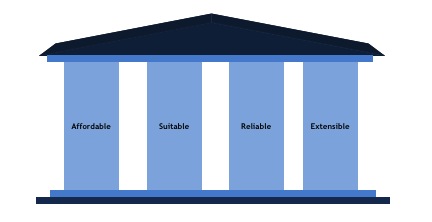After building/looking at many products, working in different product organizations and being a customer (buyer or consumer) of many products I have come to belief that Product Managers must understand thei Product Promise and plan to deliver their products based on strong product pillars. Simply put, Product Promise cannot be delivered without understanding Product Pillars.
The first question, which one may ask is ‘what is a product promise’?
A product promise is the implied commitment made to customers by a company. It embodies everything that the company, brand, marketing, features and benefits and product description convey. Put simply, a product promise is kept if the customer has an experience that is at least as good as what they expected based on what the company told them beforehand.[i]
The next logical question would then be ‘what are these product pillars about’?
The product pillars form the logical backbones for the products, which if taken into account correctly allow the organizations to deliver product promise. The main product pillars for any products are Affordability, Suitability, Reliability, and Extensibility.
The question may arise…aren’t product pillars similar to product attributes then?
The answer is NO. Product attributes reside in the product, while benefits reside in the customer. For example, a cigarette can have reduced nicotine content (a concrete attribute), providing the customer the benefit of a less harmful smoking experience. Or basketball shoes can have extra support around the ankle (an attribute), reducing the wearer’s chance of injury[ii]. On the other hand product pillars are subjective upholders of the product, which may or may not reside in the product. For example, some product pillars such as Reliability & Extensibility reside in the product but Affordability & Suitability are perceptions about the product.

Exhibit 1: The Product Pillars
Now let us talk about the most common product pillars, which must be put in place to deliver the product promise.
Affordable does not mean either priced low or high but it’s priced appropriately for the market it supposed to serve. For example, if iPhone is priced too low then it will lose its sheen on being a premium product but if priced too high may not become widely used gadget. In short, the product must be appropriately priced for it to be within affordable range of prospective customers.
Suitable products most likely fall in the category of being right fit for the job. For example, Blackberry phones are suitable to be used by executives but may not be right for youngsters, who want to play music on their phone. Suitability of the product is important to make sure that the product delivers what is expected by the buyer.
Having Suitable product is not enough but it has to be Reliable as well. What’s point in having a Blackberry or iPhone but not able to do what one wants to do with it on a consistent basis to obtain predictable results. Imagine someone buys an iPod, which does not allow the buyer to listen to different types of music without failing once during every song or giving noisy sound in the middle of the song. Would you consider buying unreliable product? I won’t. In essence Reliable pillar supports the responsibility of product being stable, usable & predictable.
Extensible is one of the most commonly ignored pillars of the products. When a consumer buys an electronic gadget today, but cannot extend its use after 6 months (whatever may be the reason such as technology upgrade or customer needs get changed etc.) then majority of the consumers will decide not to buy such gadget or least postpone the decision to buy such product. The obvious reason being no one wants own obsolete product or product, which becomes obsolete fairly quickly. Although this pillar makes more sense for Electronic & IT type of products the principle remains that majority of consumers would want some assurance that the products they buy today will not become obsolete tomorrow.
In conclusion, I strongly believe that organizations that don’t understand the product pillars, and do not use them to build their products will rarely succeed in the long run. On the contrary, organizations, which build their products on the strong foundation of product pillars, will be able to deliver the product promise and generally command a respect among their customers.
[i]Is Your Product Promise Really A Promise? http://www.aipmm.com/html/newsletter/archives/000048.php
[ii] What’s the difference between a product attribute and a product benefit? http://www.marketingprofs.com/Faqs/showfaq.asp?ID=89&CatID=4